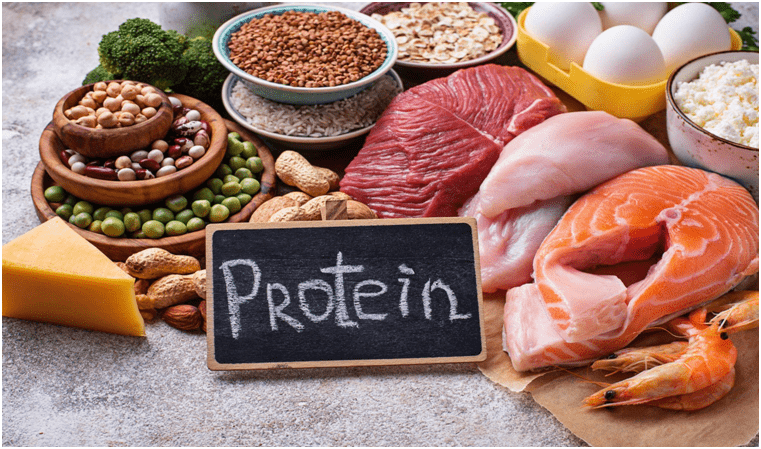Dieting and weight loss often seem like a never-ending battle against the scales. For many, the quest for a slimmer waistline means endless calorie counting, restrictive diets, and forgoing favorite foods. But what if the answer wasn’t in eating less but understanding how your body processes what you eat? Enter the realm of metabolism – the master controller of energy burn. This complex process has long been a topic of interest and research, with many seeking ways to “hack” or “boost” it. This article sheds light on the details of metabolism and how it’s intimately tied to your muscle mass.
Dieting and weight loss often seem like a never-ending battle against the scales. For many, the quest for a slimmer waistline means endless calorie counting, restrictive diets, and forgoing favorite foods. But what if the answer wasn’t in eating less but understanding how your body processes what you eat? Enter the realm of metabolism – the master controller of energy burn. This complex process has long been a topic of interest and research, with many seeking ways to “hack” or “boost” it. This article sheds light on the details of metabolism and how it’s intimately tied to your muscle mass.
What Is Metabolism?
At its core, metabolism is the sum of all chemical reactions within the body that maintain life. These processes allow organisms to grow, reproduce, maintain structures, and respond to their environments. The metabolism is often divided into two categories: catabolism, where substances are broken down to release energy, and anabolism, where energy is used to construct components of cells, such as proteins and nucleic acids. The rate at which these processes occur, known as the metabolic rate, determines how many calories your body burns in a day. It’s influenced by age, gender, body composition, and genetics. For some, a “fast” metabolism means they can eat more without gaining weight. A “slow” metabolism can make weight loss more challenging for others.
Metabolism and Muscle Mass
Muscle plays a pivotal role in the metabolic process. Muscle tissue burns more calories at rest than fat tissue. In fact, according to a study published in the Journal of Clinical Investigation, for every pound of muscle you gain, your body burns an extra 50 calories per day at rest. Thus, increasing muscle mass can elevate your resting metabolic rate, making your body a more efficient calorie-burning machine. This is why strength training and building lean muscle are often recommended for those looking to improve their metabolism.
Notable Mention: Contrary to popular belief, snacking frequently doesn’t necessarily boost your metabolism. When you take in a small amount of calories, you stimulate insulin, which can lower blood sugar levels. This may leave you feeling hungrier in an hour. The act might be stimulating hunger rather than metabolism. Dispelling the myth: you don’t need to eat five times daily to rev up your metabolic engine.
How To Boost Your Metabolism To Burn Calories, lose weight, and promote a healthy lifestyle
Unlocking the power of your metabolism can be the difference between weight loss stagnation and steady progress. The great news? There are actionable steps you can take to enhance this energy-burning force. From the fluids you drink to how you exercise, these strategic choices can amplify your metabolic rate:
⦁ Drink Enough Water
Studies have shown that drinking water can momentarily boost metabolic rate by 10-30%. It also aids in lipolysis – the body’s mechanism of breaking down fat cells for energy use. Beyond metabolism, staying hydrated helps detoxify the body, promoting satiety and ensuring the efficient functioning of cellular processes.
⦁ Get Enough Sleep
Often overlooked, sleep is a pillar of metabolic health. Chronic sleep deprivation can hinder the body’s insulin sensitivity, leading to the inefficient use of sugars from your food. This can result in fat storage and weight gain. Moreover, lack of sleep can imbalance hunger hormones, increasing appetite and calorie intake. For most adults, 7-9 hours per night is the golden range for optimal metabolic functioning. Remember, it’s not just about the quantity but also the quality of sleep you get.
⦁ Strength Train
Strength training is often synonymous with resistance or weight training, which holds the magic wand for metabolic enhancement. When you engage in strength training, you build muscle and set the stage for a more active metabolic rate. Muscles are metabolically active tissues; the more you have, the more calories you burn—even at rest. Furthermore, post-exercise, the body goes into a phase called Excess Post-Exercise Oxygen Consumption (EPOC), leading to a heightened calorie burn even hours after your workout. By incorporating weights, resistance bands, or even body-weight exercises into your routine, you’re sculpting a toned physique and ensuring a vibrant metabolic engine.
⦁ Interval Train
Interval training, specifically High-Intensity Interval Training (HIIT), has emerged as a metabolic powerhouse. Instead of continuous, steady-state exercise, HIIT involves short bursts of intense activity followed by rest or low-intensity periods. This method boosts your metabolism and can keep it elevated for hours after the workout, a phenomenon termed the “afterburn” effect. Studies suggest that HIIT can burn more calories during the workout and improve oxygen consumption, mirroring the effects of longer endurance training in a fraction of the time. For those with a tight schedule but big metabolic goals, interval training can be the answer.
⦁ Eat Enough Calories & more protein
To keep your metabolism at its peak, consuming adequate calories is essential, tailored to your activity level, age, and other factors. Prioritizing nutrient-dense foods will fuel your body without compromising your metabolic vigor.
Protein is pivotal in metabolism, muscle building, and overall health. Eating protein has been shown to boost metabolic rate by 15-30% for a few hours. This phenomenon is known as the Thermic Effect of Food (TEF) – the energy required to digest, absorb, and process nutrients. Protein’s high TEF means you burn more calories digesting it than fats or carbs. Additionally, protein aids in muscle repair and growth, supporting the muscle’s role in boosting metabolism. High-quality protein sources like lean meats and eggs can elevate your metabolic ability.
⦁ Drink Caffeine
The morning cup of coffee or tea does more than just wake you up. Caffeine can provide a notable boost to your metabolism. Research indicates that caffeine can increase metabolic rate by 3-11%, enhancing fat burning. Beyond the immediate effects, regular moderate caffeine consumption might also improve endurance during exercise, allowing for more extended, more intense workouts. However, moderation is key. Excessive caffeine can lead to insomnia, nervousness, and other side effects. Finding the right balance that benefits metabolism is essential without compromising overall well-being.
Bonus Tip:
Optimize Macros and Exercise to Elevate Metabolic Rates Weekly
A well-balanced diet and consistent exercise are fundamental tenets of health, but there’s an intricacy between the two that can unlock metabolic wonders. It’s all about the synergy between macros and movement. Studies have shown that when individuals precisely calibrate their macronutrient intake (proteins, fats, and carbohydrates) with their exercise regimen, they can boost their metabolism substantially.
Here’s the science in a nutshell: Proteins require more energy to metabolize, carbohydrates or fats fuel our workouts and provide long-lasting energy. When we optimize our macros, especially with the nature and intensity of our workouts, our bodies become more efficient in burning calories. Established over a week or so, this efficiency translates to a ramped-up metabolic rate.
The result? A desirable state where you’re consuming more food (within macro limits) and still not gaining unwanted weight, thanks to a supercharged metabolism. It’s the dream scenario: eat more of what you love, maintain or even shed weight, and feel energetic. With the right balance, our bodies can be finely tuned machines that reward us in delightful ways.

Bottom Line
Our metabolic rate isn’t just a genetic lottery; it’s influenced by our daily choices. From the beverages we sip to our workout regimens, every decision casts a ripple effect on this powerful process. Remember, it’s not about seeking drastic, quick fixes but instead embracing sustainable habits that nurture and elevate our body’s innate functions.







